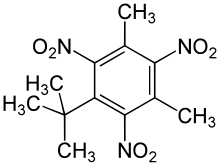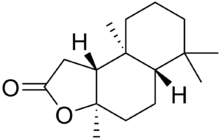Synthetic musk
Synthetic musks, known as white musks in the perfume industry, are a class of synthetic aroma compounds to emulate the scent of deer musk and other animal musks (ambergris, castoreum and civet). Synthetic musks have a clean, smooth and sweet scent lacking the fecal notes of animal musks. They are used as flavorings and fixatives in cosmetics, detergents, perfumes and foods, supplying the base note of many perfume formulas. Most musk fragrance used in perfumery today is synthetic.
Synthetic musks in a narrower sense are chemicals modeled after the main odorants in animal musk: muscone in deer musk, civetone in civet, and ambroxide in ambergris. Muscone and civetone are macrocyclic ketones, ambroxide is a cyclic ether. Other structurally different but functionally similar compounds also came to be known as musks.
Nitro musks

- Musk xylene
- Musk ketone
(Hydrated) indanes
_Cashmeran_Structural_Formulae_V1.svg.png)
- 6-Acetyl-1,1,2,3,3,5-hexamethylindane
- Phantolide (Haarmann & Reimer)
- 4-Acetyl-1,1-dimethyl-6-tert-butylindane
- Celestolide (IFF)
- Crysolide (Givaudan Roure)
- 5-Acetyl-1,1,2,6-tetramethyl-3-isopropylindane
- Traseolide (Quest)
Cyclic ethers


- 4,6,6,7,8,8-Hexamethyl-1,3,4,6,7,8-hexahydrocyclopenta[g]benzopyrane
Macrocyclic ketones

- (R)-3-Methylcyclopentadecanone
- (Z)-9-Cycloheptadecen-1-one
- Cyclopentadecanone
- Exaltone (Firmenich)
- 3-Methylcyclopentadec-4/5-en-1-one
- Muscenone (Firmenich)
- 5-Cyclohexadecen-1-one
- TM II SP (Soda Aromatic)
- Ambretone (Takasago)
Aliphatic lactones
- γ-Decalactone
- γ-Dodecalactone
Polycyclic lactones

- Decahydrotetramethylnaphthofuranone
- Sclareolide (found in clary sage)
Macrocyclic lactones

- 15-Pentadecanolide
- Cyclopentadecanolide (Haarmann & Reimer)
- Exaltolide (Firmenich)
- Pentalide (Soda Aromatic)
- Oxacyclohexadec-12/13-en-2-one
- Habanolide (Firmenich)
- Globalide (Haarmann & Reimer)
- 12-Oxa-16-hexadecanolide
- Musk R 1 (Quest)
- α,ω-Dodecanedioic acid ethylene ester
- Arova 16 (Degussa)
- (10Z)-13-methyl-1-oxacyclopentadec-10-en-2-one
- Nirvanolide (Givaudan Roure)
- ω-6-Hexadecenlactone
- Ambrettolide (found in Ambrette seed oil)
- 14-Methylpentadecano-15-lactone
- Muscolide (found in Angelica seed oil)
Hydronaphthalenes

- 1-(1,2,3,4,5,6,7,8-octahydro-2,3,8,8,-tetramethyl-2-naphthyl)ethan-1-one
- (-)-(6S,7S)-3,5,5,6,7,8,8-heptamethyl-5,6,7,8-tetrahydronaphthalene-2-carbaldehyde
- Vulcanolide (Firmenich)
- 6-Acetyl-1,1,2,4,4,7-hexamethyltetraline (AHTN)
- Fixolide (Givaudan Roure)
- Tonalide (Haarmann & Reimer)
- Tetralide (Bush Boake Allen)
Alicyclic musks

Alicyclic musks, otherwise known as cycloalkyl ester or linear musks, are a relatively novel class of musk compounds. The first compound of this class was introduced 1975 with Cyclomusk, though similar structures were noted earlier in citronellyl oxalate and Rosamusk.[1] Alicyclic musks are dramatically different in structure than previous musks (aromatic, polycyclic, macrocyclic) in that they are modified alkyl esters.[2] Although they were discovered prior to 1980, it was only in 1990 with the discovery and introduction of Helvetolide at Firmenich that a compound of this class was produced at a commercial scale.[1] Romandolide, a more ambrette and less fruity alicyclic musk compared to Helvetolide, was introduced ten years later.[2]
Environmental and health issues
Synthetic musks are lipophilic and tend to deposit and persist in fat tissue for a very long time. Nitromusks and polycyclic musks – having been used for 100 years – have low biodegradability and accumulate in the environment. Their environmental effects aside, these chemicals pose no significant risks to human health.
References
- 1 2 Kraft, Philip (2004). "'Brain Aided' Musk Design". Chemistry & Biodiversity. 1 (12): 1957–1974. doi:10.1002/cbdv.200490150. PMID 17191832.
- 1 2 Eh, Marcus (2004). "New Alicyclic Musks: The Fourth Generation of Musk Odorants". Chemistry & Biodiversity. 1 (12): 1975–1984. doi:10.1002/cbdv.200490151. PMID 17191833.